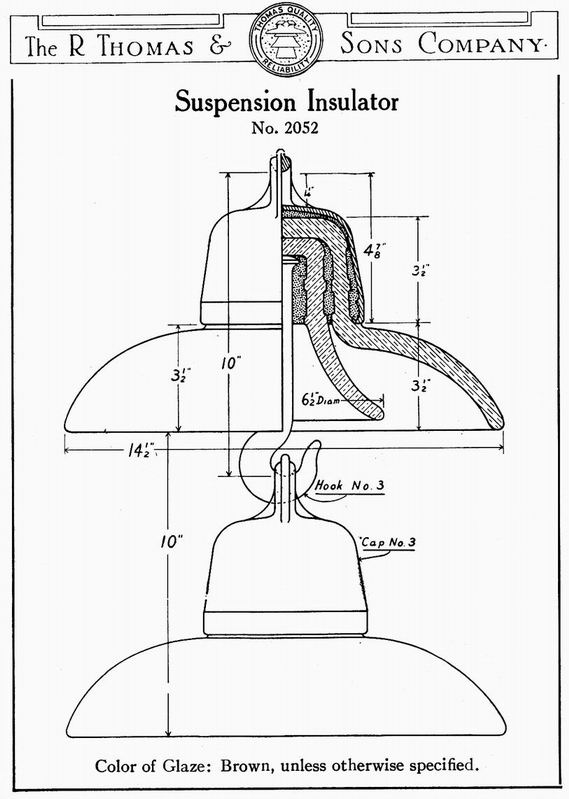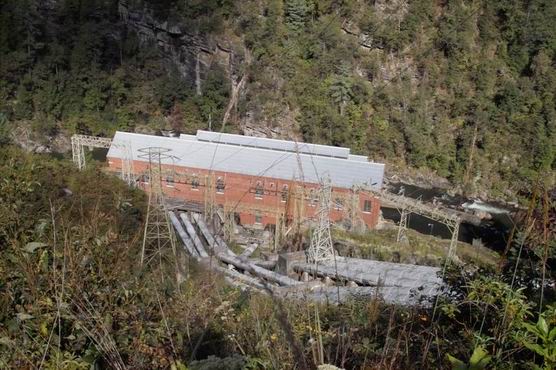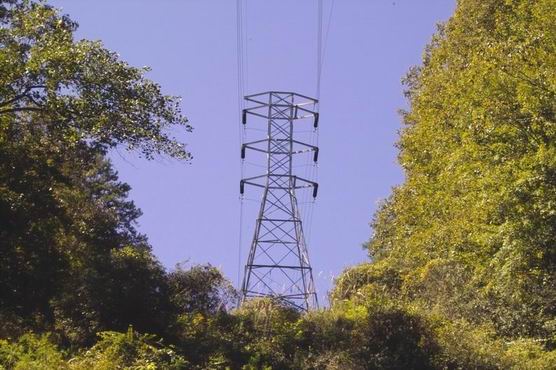Remnants of the
Southern Power Co. Part 2
Very Rare Thomas 2-Part Suspension Insulator
(Published in the Spring 2004
issue of Power Line Explorer Journal)
By Carver Mead & Barbara Smith
R=∞
Home
Page
2 Page 3
[Carver and Barb have
researched several early lines and made successful trips to each finding rare
early porcelain insulators each time. The excitement they share for these
hunts is extraordinary. Perhaps their greatest discovery was on the Kern-1
line where they found not just one M-4800, but M-4800's from three different
manufacturers! Don't miss reading their story.]
Volume I, No.2 of the Power
Line Explorer Journal contains an excellent article by Steve Jones detailing
his research on, and hunting of, the historic lines in North Carolina.
He was able to find one of the original M-3471’s used on a 50kV section
of the line. The present article
may be viewed as a continuation, in which we were specifically searching for the
huge (14.5 in. diameter) 2-part Thomas suspension pieces, shown on page 29 of
Steve’s original article.
 These insulators are historic for a number of reasons:
They were part of a power system that grew, by 1914, into the first real
power grid in the world. They were
Thomas’ answer to the coveted Victor 273 2-part “Duncan” suspension. Very few are in captivity:
Bill Rohde has one, and Ben Kirsten found a couple somewhere in the west
(and he isn’t telling where). We
are not aware of any recovered from the Southern Power system.
These insulators are historic for a number of reasons:
They were part of a power system that grew, by 1914, into the first real
power grid in the world. They were
Thomas’ answer to the coveted Victor 273 2-part “Duncan” suspension. Very few are in captivity:
Bill Rohde has one, and Ben Kirsten found a couple somewhere in the west
(and he isn’t telling where). We
are not aware of any recovered from the Southern Power system.
We scheduled a trip to the Carolinas for the last
week in September and first week in October 2003.
We flew in to the Raleigh-Durham airport, rented a car, and started
looking for the line to Greensboro, the easternmost substation of the original
1909 100kV tower line. The area was all built up, and line had modern towers – not
original. We traced the line
southwest and finally found the substation at Salisbury.
There, out in the middle of a mowed area, we found the very first tower
that was original – just like the EW pictures.
The whole tower was bare except for the static line.
We traced the original line southeast towards Albemarle.
The towers were abandoned, with only the static line holding them
together, very much as Steve had found on the 50kV line.
From 1915 Thomas
catalog
Although much of the area is becoming populated, one
section contours around a hill and we were able to fight our way through the
brush to some tower sites. We found
a few shards of the original insulators, enough to identify the huge outer skirt
and the lily-shaped inner skirt, but no metal parts.
We tried to get a glimpse of the power plants around Albemarle, but found
nothing but keep-out signs. Following
the line west through South Carolina was much of the same story---mostly rebuilt
line, private property everywhere, mowed right-of-way, and only a few scraps of
porcelain.
After a few days of this, we decided that we were never
going to find anything this way. So it was back to the books to find a
better approach. The 1917 book
“American Hydroelectric Practice” by Taylor & Braymer includes, on
p.202, the detailed mechanical drawing of the 2-part Thomas suspension shown
above.
The caption for this drawing reads “The insulator
shown --- for 110,000 volts has been used on lines of the Southern Power Company
and those of the Georgia Railway and Power Company.”
If we couldn’t find any on the Southern Power system, maybe we could
find something on the Georgia Railway & Power system.
Development of hydroelectric power in
northeastern Georgia began in 1905 but ran into financial and legal problems,
compounded by the devastating depression of 1907. After a series of mergers, a plant was completed at Tallulah
Falls and went on line in 1913. The
plant had a head of 608 ft., at the time the highest in the eastern U.S.
The plant generated 60,000kW, making it the third largest single plant in
the U.S., behind Niagara and Keokuk. The
plant was nestled into the hillside at the bottom of Tallulah gorge, the
generators being located nearest the river, and the transformers in an adjoining
building located farther from the river and higher up the hill.
Viewed from above, the transformer building
dominates the view of the plant, with just the roofline of the generator
building being visible. The
architecture is quite attractive, and the plant, along with others added in the
20’s, continues in operation as an important contributor to Georgia’s
electrical power. An original tower
is conspicuous just to the left of the penstocks.

Two excellent Electrical
World articles appeared in December of 1913 describing the system.
The following quote is from the second of these.
“The energy from the Tallulah Falls station is
transmitted over a steel tower line from Tallulah Falls to Atlanta, a distance
of 90 miles…The insulators are all of the suspension type---four-disk,
two-part insulators manufactured by R. Thomas & Sons Company of East
Liverpool, Ohio, being used on the main line from Tallulah Falls to Atlanta, and
insulators with five 10-in. disks, manufactured by the Ohio Brass Company,
Mansfield, Ohio, on the other circuits.”
So we knew where to look. When we arrived we found four
lines radiating from the plant: One
north to the Terrora plant, one south to the Tugalo plant, one across the river
to the east, and the main line to Atlanta, which had the original towers, still
in service!

The towers even had the original tower signs, complete with
tower number---$25 went a lot further in those days than it does today!

Southern Power: Page
2 Page 3
R=∞
Home
 These insulators are historic for a number of reasons:
They were part of a power system that grew, by 1914, into the first real
power grid in the world. They were
Thomas’ answer to the coveted Victor 273 2-part “Duncan” suspension. Very few are in captivity:
Bill Rohde has one, and Ben Kirsten found a couple somewhere in the west
(and he isn’t telling where). We
are not aware of any recovered from the Southern Power system.
These insulators are historic for a number of reasons:
They were part of a power system that grew, by 1914, into the first real
power grid in the world. They were
Thomas’ answer to the coveted Victor 273 2-part “Duncan” suspension. Very few are in captivity:
Bill Rohde has one, and Ben Kirsten found a couple somewhere in the west
(and he isn’t telling where). We
are not aware of any recovered from the Southern Power system.

